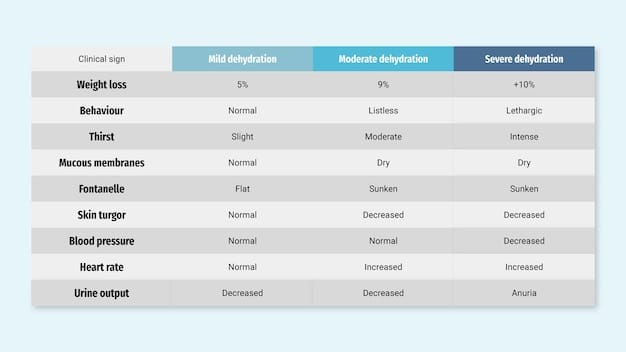REIT Valuation: A Deep Dive into FFO and AFFO Metrics

REIT Valuation Metrics Using Funds From Operations (FFO) and Adjusted Funds From Operations (AFFO) offers a more accurate financial analysis for Real Estate Investment Trusts (REITs), providing insights into their operational performance and profitability beyond traditional net income figures.
Understanding how to accurately value Real Estate Investment Trusts (REITs) is crucial for investors. While traditional metrics have their place, REIT Valuation Metrics: A Deep Dive into Using Funds From Operations (FFO) and Adjusted Funds From Operations (AFFO) for Accurate Analysis provides a more insightful view of a REIT’s financial health and operational performance.
Understanding REIT Valuation Metrics
REITs, or Real Estate Investment Trusts, operate differently from typical companies. Their main job is to own or finance real estate. Because of this unique setup, standard accounting measures like net income don’t always paint the full picture. That’s where specialized REIT valuation metrics come in handy.
The Importance of Specialized Metrics
Traditional metrics can be misleading for REITs because they often include depreciation, which is a non-cash expense. For REITs, real estate depreciation is a significant figure. Specialized metrics like Funds From Operations (FFO) provide a clearer view of a REIT’s cash flow. These are necessary to value REIT valuation metrics.
Different metrics have different purposes, but using tools like FFO and AFFO provides a true view of how well a REIT is performing and can help you distinguish between good investments and bad ones.
- More Accurate View: FFO and AFFO take out variables such as depreciation, offering a clearer image.
- Comparable Analysis: These metrics provide an equal playing field when one assesses many REITs.
- Cash Flow Insights: Investors can gain insight regarding the actual cash-generating ability.
In essence, understanding REIT valuation metrics is important to make informed investment decisions, reflecting the true financial performance of this unique asset.
Delving into Funds From Operations (FFO)
Funds From Operations, or FFO, is the most common supplemental metric when evaluating REITs. It adjusts net income to exclude items that don’t reflect a REIT’s true operating performance.
What is Funds From Operations (FFO)?
FFO is primarily net income with depreciation and amortization added back, and gains/losses from property sales subtracted. The main goal is to measure the cash flow a REIT generates from its core business operations. These metrics give a realistic picture of cash generation, making an informed evaluation process possible.
FFO helps investors evaluate the cash flow a REIT produces. FFO focuses on the sustainability of a REIT’s income, offering a more precise financial performance indicator.

The FFO Calculation
The basic formula goes like this: FFO = Net Income + Depreciation and Amortization – Gains from Sales of Property + Losses from Sales of Property. This removes distortions from accounting conventions, providing a more precise view of a REIT’s cash-generating potential.
- Net Income: The start point, however, is modified to make up for accounting oddities.
- Depreciation/Amortization: Included because these are non-cash expense items that lower earnings, yet have nothing to do with the ability of REITs to generate cash.
- Gains/Losses from Property Sales: These are excluded because they are not ordinary, ongoing operating activities.
FFO offers an improved measure over net income to assess a REIT’s financial operations, enhancing transparency and enabling one to make more informed choices.
Adjusted Funds From Operations (AFFO): A More Refined Metric
AFFO goes one step further than FFO, offering an even more detailed look at a REIT’s financial health. AFFO seeks to catch a better picture of expendable cash and takes into consideration regular capital expenditures and leasing costs.
Understanding Adjusted Funds From Operations
AFFO starts with FFO and then subtracts maintenance capital expenditures and sometimes adds back items like straight-line rent adjustments and non-cash rent. This allows a more conservative image of the actual cash flow being generated to be created, as well as how available the cash flow is for dividends.
Investors use AFFO to measure a REIT’s dividend-paying capacity. AFFO is very useful for gauging the sustainability and safety of a REIT’s dividend through providing an in-depth insight concerning a REIT’s ongoing financial capacity.
Calculating AFFO
The AFFO equation is generally like this: AFFO = FFO – Maintenance Capital Expenditures – Leasing Commissions + Straight-Line Rent Adjustments + Other Non-Cash Adjustments. It provides a more conservative calculation of the actual cash flow available to REITs.
- Maintenance Capital Expenditures: These tend to be omitted from FFO, however, they do constitute recurring cash outlays that are necessary for upkeeping any REIT’s property.
- Leasing Commissions: Include the costs of securing tenants, providing for a complete picture of operational expenses.
- Straight-Line Rent Adjustments: It takes into consideration the fact that rents are recognized consistently; it does not reflect the changes over the lease term.
Ultimately, AFFO delivers an improved picture of where cash is to be found, taking into consideration both essential capital expenditures as well as renting expenses.
FFO vs. AFFO: Which Metric Should You Use?
Both FFO and AFFO are valuable REIT valuation metrics, but they serve slightly different purposes. Knowing when to use each metric can give you a more finely tuned analysis of a REIT’s financial performance.
Comparing FFO and AFFO
FFO is a good starting point for assessing a REIT’s overall operational performance, while AFFO provides a more conservative view by accounting for necessary capital expenditures. In general, FFO is useful in broad comparisons, while AFFO can be used in analyzing the sustainability of dividends.
Choosing between FFO and **AFFO ** depends largely on your investment goals as well as assessment criteria; FFO looks at general operational performance and AFFO considers important capital expenditures.
When to Use FFO
Use FFO when you want to compare multiple REITs on a level playing field, without getting bogged down in the details of their capital expenditure policies. FFO is like a quick health check; it gives you a general idea of how well a REIT is doing. But, use these tools and information in evaluating **REIT valuation metrics**.
- Broad Comparisons: Ideal for comparing across diverse REITs.
- Initial Assessment: Works well for preliminary due-diligence.
- Trend Analysis: The trends can reflect operational performance developments in time.
In summary, FFO makes for a simple and direct measure of a potential REIT, particularly for quickly drawing parallels to others operating in the sector.
When to Use AFFO
Opt for AFFO when you need a more detailed analysis of a REIT’s cash flow, particularly in the context of its dividend payments. This is especially useful when assessing the financial strength over time. This helps one to consider REIT valuation metrics.

- Dividend Sustainability: Better used to see whether dividends are sustainable through cash generation.
- Detailed Analysis: Effective when carrying out intensive financial studies.
- Long-Term Viability: It is valuable when examining a company’s ability to stay financially viable over a long time.
To summarize, AFFO provides a deeper look into a company’s financial standing, including its capability to maintain its dividends.
Practical Applications: Using FFO and AFFO in REIT Analysis
Understanding FFO and AFFO is one thing, but knowing how to use them in real-world REIT analysis is another. This means you need to apply this understanding of **REIT valuation metrics** when weighing your options.
Calculating Key Ratios
FFO and AFFO can be used to calculate key ratios that provide insights into a REIT’s valuation and performance. Some common key ratios include the Price/FFO ratio and the Price/AFFO ratio. These metrics enable potential financiers to evaluate just how rich or cheap a REIT is as compared with its cash flow.
Investors use these key ratios to determine the relative value of REIT shares. These provide insights to potential financiers about the worth of the stock by looking at **REIT valuation metrics**.
Price-to-FFO Ratio
This ratio compares a REIT’s stock price to its FFO per share. It’s similar to a price-to-earnings ratio but uses FFO instead of earnings. Generally, a lower ratio may mean the REIT is undervalued, but this should be viewed within the context of the REIT’s growth prospects, quality of assets, and overall market conditions.
- Valuation Assessment: A low ratio can suggest that a REIT is underpriced.
- Comparative Analysis: It is employed when looking at a REIT in comparison to another.
- Market Context: Always take into consideration the REIT’s development forecasts in light of overall environment.
Overall, Price/FFO is a useful tool to determine whether a REIT has more value than the value assigned by its stock price.
Price-to-AFFO Ratio
Similar to the Price/FFO ratio, but it uses AFFO instead. This takes into account capital expenditures and paints a more conservative picture of value. It’s especially useful for REITs with significant capital expenditure requirements. Using this helps you in evaluating **REIT valuation metrics**.
- Conservative Valuation: Considers capital expenditure to present a more reliable valuation.
- Capital-Intensive REITs: Highly relevant for those which have substantial capital expenditures.
- Long-Term Investment: Essential for those who have a greater preference towards investment avenues for long periods.
In conclusion, Price/AFFO offers an in-depth evaluation especially if capital expenditure is one of the critical factors involved.
Common Pitfalls and How to Avoid Them
While FFO and AFFO are valuable tools, they aren’t foolproof. It’s essential to be aware of their limitations and potential pitfalls.
Limitations of FFO and AFFO
FFO and AFFO, while more accurate than net income, still rely on accounting assumptions and can be manipulated. Also, these measurements don’t account for all the cash flow drivers, so additional due diligence is always recommended. These tools give investors information regarding **REIT valuation metrics**.
Investors need to realize both the strengths and the weaknesses connected with them. FFO/AFFO will make a beneficial choice, but a deeper check must be undertaken.
Potential Manipulations
REITs can sometimes manipulate FFO and AFFO by making aggressive assumptions about depreciation rates or capital expenditure needs. Investors need to critically assess these assumptions and understand their impact on the metrics. Being aware of these weaknesses makes investors more responsible with **REIT valuation metrics**.
- Depreciation Rates: These rates can have a substantial impact on earnings and therefore may be manipulated.
- Capital Expenditure: Be alert to whether they are capitalized or expensed, as it may distort actual numbers.
- Non-Cash Items: Watch out for the accounting tricks played via non-cash revenues and other items.
By keeping the likelihood of manipulation in mind, one can protect themselves from making investment choices that could be impacted by these deceptive techniques.
Ignoring Qualitative Factors
Don’t rely solely on FFO and AFFO. Qualitative factors such as management quality, property locations, and tenant profiles also play a significant role in a REIT’s success. So, you must have a good understanding of **REIT valuation metrics**.
- Management Quality: Managers’ experience and skill can substantially impact decisions.
- Property Locations: High-quality properties within prime areas have high value.
- Tenant Profiles: A steady stream of income is derived through strong renters who bring about secure cash flow.
Therefore, a well-rounded evaluation will include combining both measurable factors with qualitative insights for a comprehensive examination.
| Key Point | Brief Description |
|---|---|
| 📊 FFO Metric | Adjusts net income by adding back depreciation and amortization, and removes gains/losses from sales. |
| 👍 AFFO Metric | Further refines FFO by subtracting maintenance capital expenditures and leasing commissions. |
| 💰 Key Ratios | Price/FFO and Price/AFFO ratios help assess if a REIT is undervalued relative to its cash flow. |
| ⚠️ Common Pitfalls | Be wary of manipulation and always consider qualitative factors, not just financial metrics. |
FAQ Section
▼
FFO, or Funds From Operations, is a measure used in REIT valuation that adjusts net income to exclude items like depreciation and gains/losses from property sales, providing a clearer picture of a REIT’s operating performance.
▼
AFFO, or Adjusted Funds From Operations, goes further than FFO by also subtracting maintenance capital expenditures and adding back items like straight-line rent adjustments, offering a more refined view of cash flow.
▼
FFO and AFFO provide a more accurate reflection of a REIT’s financial health and cash-generating ability compared to traditional metrics, helping investors make informed decisions about dividend sustainability and investment value.
▼
While valuable, FFO and AFFO can be manipulated and don’t account for all cash flow drivers or qualitative factors, so it’s important to critically assess the assumptions and consider additional due diligence.
▼
Use FFO and AFFO to calculate key ratios like Price/FFO and Price/AFFO to determine if a REIT is undervalued, and always consider qualitative factors like management quality and property locations for a comprehensive analysis.
Conclusion
In conclusion, mastering REIT Valuation Metrics: A Deep Dive into Using Funds From Operations (FFO) and Adjusted Funds From Operations (AFFO) for Accurate Analysis is essential for making informed investment decisions in the REIT sector. By understanding the nuances of FFO and AFFO, investors can gain a clearer picture of a REIT’s financial health and cash-generating ability, ultimately leading to more successful investment outcomes.





